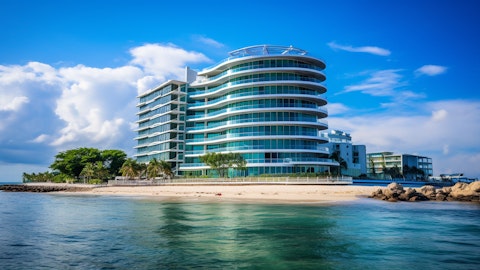Credit, real estate in Brazil, because interest rates are projected to come down and GPMS, mainly secondaries, right, because we are here in the secondaries, as you know, is actually giving liquidity to general partners and LPs that are willing to come out of funds. Given that DPI has been slower globally, these GPs and LPs are looking for liquidity, and that’s how a secondary fund comes in and provides that liquidity. So that’s why it’s a sought after product, right, because it’s the moment for secondaries, for the credit, because of the high interest rates. Real estate in Brazil, because interest rates start coming down. And you probably followed our real estate investment trust. We’re trading at a small discount a year, year and half ago of 10% to 15%.
Now they’re trading at a premium. And number three, secondaries, right? So of course they liked the team, because 100% of them approved the change of control. Of course they said they’re going to support us, which was very, very good. And also it has to do with the fact that it’s a hot product under this market environment that we’re living, okay? Now as the closing happened, we are going to be able to do official fundraising, because we couldn’t, we were prohibited by the regulatory authorities. And we’re going to have a better view and I’ll keep you guys posted, but we were very pleased. As far as our projections are concerned, again just to repeat, we were conservative and we did not project much fundraising for this product this year.
Marco D’Ippolito: So to complement one topic here. Bear in mind that most of this fee paying AUM is paying fees over NAV and the natural appreciation of the assets will incorporate into the revenue of the business. So that’s also — because the unit has been performing quite well with 20% returns on secondaries and co-investments and about 16% returns on primaries, that is a meaningful contribution to the fee paying AUM.
Ricardo Buchpiguel: So if I may do a quick follow-up here on another topic. We saw that during the quarter the level of deployments in private equity and infrastructure declined a little bit. So it was like — previously around $100 million and it was around $400 million, if I’m not mistaken, in Q1. So I wanted to understand if that is something that, a deceleration that happened only for a quarter and we should see the pace closer to the previous quarters going forward, or we should see like kind of a more structured deceleration in terms of deployment?
Alex Saigh: No, it’s just a coincidence that it happened in this quarter, what you just described, Ricardo. There’s nothing more to it, to be honest. And I think there is, in general, you’re going to see the first quarters are a little slower. And again, don’t ask me why, but I think there’s a big human nature factor there. People get close to the end of the year, they want to close a deal, they have goals to meet. And not only the seller wants to sell, the buyer wants to buy and the advisers want to get their fees. So everybody kind of pushes in the right direction to close the deal. And then the first quarter is normally quieter, that’s more or less the path. Even on the privatizations and concessions, maybe the government has the same kind of human nature trait.
They don’t do much concessions and privatizations in January and February, I think it has to do with everything that I said. So the year starts picking up as of March, April. It’s a natural circumstance, nothing to report there besides it’s something natural. Nothing structural going on, Ricardo.
Operator: This concludes the question-and-answer session. I would now like to turn it back to Alex Saigh for closing remarks.
Alex Saigh: Well, thank you very much. I think the final message here again is FRE per share that’s, I think, the number one, two, three message here. Growing FRE per share very healthily this year versus next. And again, the FRE per share for this year of $1.08 to $1.12 per share compared to $0.99 last year is affected by the fact that we issue the shares, but we don’t get the full benefit of the acquired assets. So as you look into next year, 2025, that we have the full year of the acquired assets running through our P&L and of course then reflecting them in our FRE, we’re projecting $1.25 FRE per share to $1.40 FRE per share, which is the $200 million to $225 million FRE number that I gave you guys. And I’m very confident with those numbers.
But even if we look at these numbers here, the $1.40, the $225 million, versus the $0.99, we are increasing FRE per share by 40% between these two years, ’24, ’25. And so we’re comfortable there. We’re comfortable we’re going to hit the numbers. I think using the FRE per share I think answers a lot of the questions on potential dilution for acquisitions. And going back to the strategic instruments of using shares for acquisitions, it’s not a question of just capital structure. It’s strategically important for us to retain the management, the portfolio management, that comes along with these acquisitions as we do lock up these shares for five years, et cetera. So we have — it is a very important instrument, compensation, retention and acquisition instrument.
Even if we had all the money possible in the world in our balance sheet, I think we would still use some shares in order to retain those people, as we are a very people driven business. So thank you very much again for your time. And I know that it was a very, very busy day today. So you guys being here in our call is an honor to us, because other of our peers and other companies are releasing their results. So again, thanks for your patience. Thanks for your support. I hope to see you guys in person. Thank you. Bye-bye.
Operator: Thank you for your participation in today’s conference. This does conclude the program. You may now disconnect.
Follow Patria Investments Ltd (NASDAQ:PAX)
Follow Patria Investments Ltd (NASDAQ:PAX)
Receive real-time insider trading and news alerts


